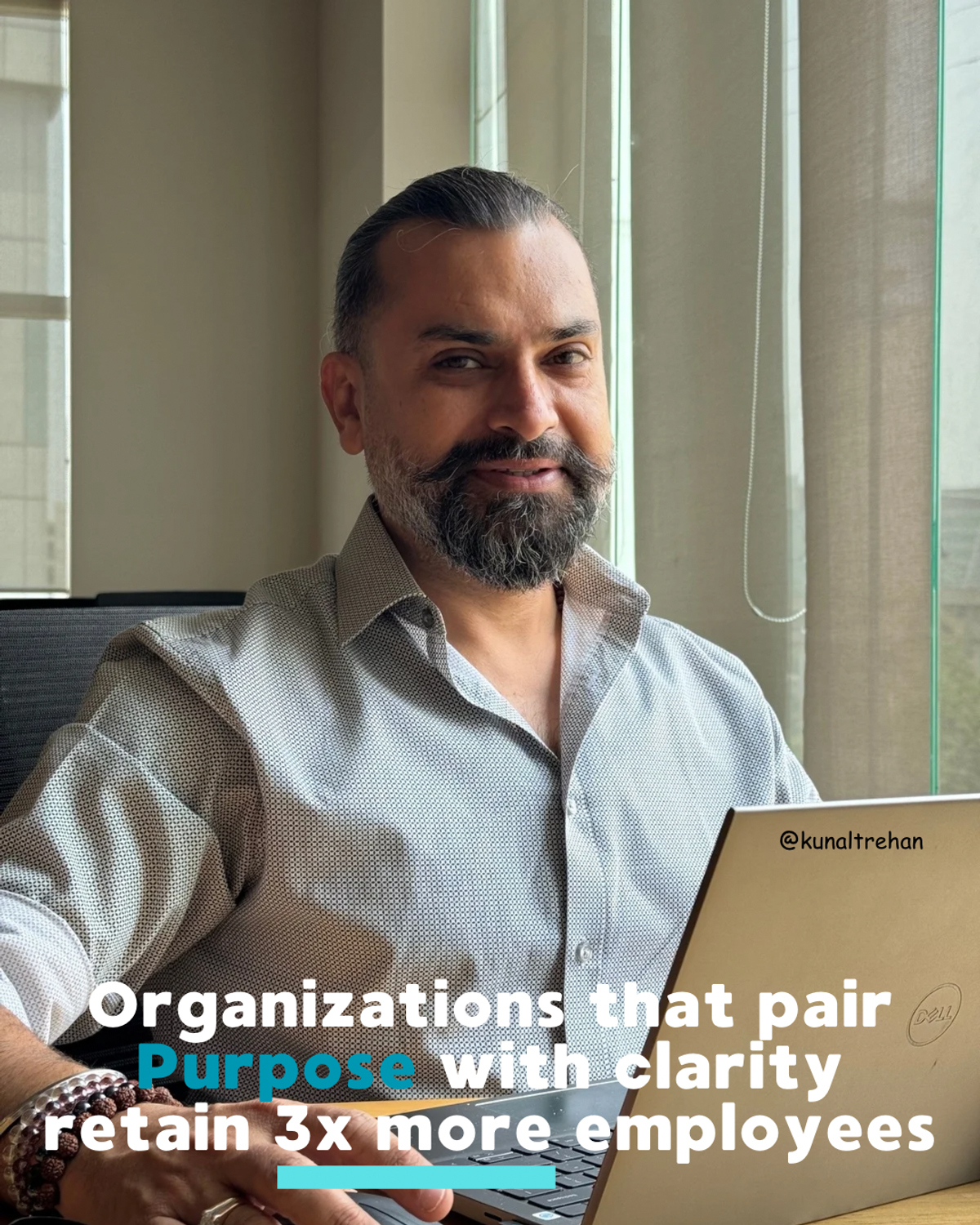Organisations that pair Purpose with clarity retain 3x more employees
Why Purpose at Work Isn’t Just a Buzzword—It’s the Future of Great Workplaces
Most employees aren’t quitting because of money. They’re quitting because their work feels meaningless.

Kunal Trehan
Workplace strategy consultant

If you’ve sat in a leadership meeting recently and heard the phrase “purpose-driven culture,” you’re not alone. It’s one of the most talked-about ideas in corporate boardrooms today. But beyond the buzz, what does it really mean? And more importantly, why should leaders care?
The answer is both simple and powerful: employees today aren’t just looking for jobs—they’re looking for meaning.
The wake of the COVID-19 pandemic brought about a reckoning for workers around the world. It wasn’t just about health or job security. It was a soul-searching moment. People began asking deeper questions: “Is my work meaningful?” “Am I making a difference?” “Do I want to keep doing this?”
For many organizations, especially those struggling with talent retention or quiet quitting, these questions became hard to ignore.
According to the 2023 “Power of Purpose in the Workplace” report by Great Place To Work®, there is now hard data linking purpose to business success. Employees who say their work has meaning are far more likely to stay, perform better, and recommend their employers to others. It’s not just a feel-good sentiment—it’s a business imperative.
Let’s take a step back and consider what this looks like in real life. Think of an employee working in a frontline role at a supermarket, a job often viewed as transactional. At Wegmans, one of the top-rated workplaces in the retail sector, the story is different. Each store features a “W Board” where the company’s mission is proudly displayed. It doesn’t just hang on the wall—it’s a living part of the employee experience, integrated into training, performance goals, and daily conversations.
It says to every employee, “You matter. Your work matters.” That message has a powerful ripple effect. It transforms routine tasks into meaningful contributions to a larger purpose. And people stay when they feel they belong to something bigger than themselves.
It’s not just retail. At AbbVie, a biopharmaceutical giant, the culture is steeped in values that employees resonate with—supporting well-being, transforming lives, operating with integrity. These aren’t just slogans. They’re a shared language that guides behavior, decision-making, and ultimately, performance.
The data shows that this connection to purpose boosts not just morale, but business metrics too. When researchers at Harvard Business School dug into Great Place To Work®’s database of 450,000 employee responses, they found something critical: purpose alone didn’t correlate with profitability. But purpose paired with clarity? That’s where the magic happens.
Clarity—particularly from middle management—is the bridge between purpose and performance. Employees need more than lofty mission statements; they need to understand how their individual role connects to that mission. When that connection is made clear, companies outperform the market by nearly 7%.
This insight is especially important for middle managers, often the unsung heroes of culture. It’s not the C-suite alone that drives engagement. It’s the team leads, the supervisors, the mentors who translate values into everyday actions. If they’re aligned, if they communicate clearly, if they believe in the mission—then the rest of the organization follows.
And the impact? Employees stay. They give more. They innovate.
Let’s talk about innovation for a moment. It’s easy to assume that creativity lives in the strategy rooms or product labs. But innovation can come from anywhere—especially from the frontline, if they’re empowered to contribute. Unfortunately, that’s not always the case.
The report shares a striking example. A long-serving employee at a service organization felt frustrated when new hires received the same pay as veterans. That disconnect—between what’s promised and what’s experienced—can extinguish a sense of purpose. Resentment sets in, innovation falters, and valuable institutional knowledge gets lost as experienced people walk away.
This is a lesson in fairness, too. Meaningful work must be accompanied by a culture that values equity, transparency, and trust. In sectors like healthcare, where purpose is inherently built-in, issues like unfair promotions or pay disparities can still drive disengagement.
Purpose without context, after all, isn’t enough.
Another compelling insight from the report comes from generational dynamics. Millennials and Gen Z, now the largest cohort in the workforce, are leading the charge for meaningful employment. For them, purpose isn’t a perk—it’s a dealbreaker. They’re willing to leave companies that don’t reflect their values or give them a sense of impact.
At companies recognized as Best Workplaces for Millennials™, these younger professionals are three times more likely to stay when they feel their work is meaningful. They’re five times more likely to recommend their employer. These are not minor differences. They are markers of loyalty and advocacy that can shape a company’s brand and culture for years to come.
So what does all this mean for workplace leaders?
First, it’s a call to action. Culture isn’t set once a year at an offsite. It’s built every day through intentional conversations, clear communication, and genuine care. It means training managers not just to manage work, but to inspire people. It means embedding purpose into job descriptions, team meetings, performance reviews—even onboarding programs.
Second, it’s a reminder that great workplaces don’t depend on geography or perks. Whether you’re in Mumbai, Manhattan, or Melbourne, what matters is how you make people feel. Are they seen? Are they heard? Do they know their contribution counts?
The Great Place To Work® data supports this. Companies across countries & regions that prioritize purpose—be it in Toronto , New York, Dubai or NCR - New Delhi —saw a dramatic increase in retention and productivity. In these organizations, 88% of employees plan to stay, compared to just 52% at average workplaces.
And finally, this is a moment for leaders to redefine success. Beyond KPIs and profit margins, what kind of workplace are you building? Are you cultivating a culture where people can thrive—not just professionally, but as human beings?
If you’re serious about building a workplace that attracts and retains top talent, start with purpose. Make it visible. Make it personal. Make it real.
Because when employees know why their work matters, they won’t just show up. They’ll show up inspired.